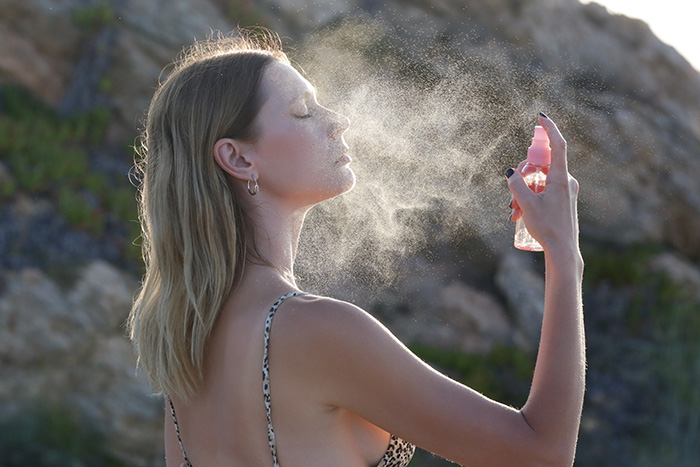Summer hacks: Are cooling sprays and facial mists safe to use to beat the heat?
Is there something that can give quick and easy relief from the warm temperatures aside from sitting in an air-conditioned room?
The Department of Health and Centers for Disease Control and Prevention shared different ways to prevent heat stroke such as drinking plenty of water, using sunscreen, and taking cold showers.
Another way to beat the heat that's becoming more popular is using cooling sprays and facial mists, which can spritz for an instant cooling effect. But are these products safe to use on your skin?
Dermatologists weigh in
"Facial sprays are an easy way to freshen and refresh your skin throughout the day. However, remember that not all facial sprays are made equal, so it's important to choose the one right for your skin," dermatologist Dr. Katrina Erika Habaluyas Luz, a.k.a. @askyourderma, told PhilSTAR L!fe.
"Some facial sprays are just plain water - and can effectively hydrate your skin especially if a sink with running water is hard to come by," she added.
Meanwhile, another dermatologist, Dr. Beatrice Chan, said to look out for ingredients in these sprays and mists.
"Nowadays, face mists are used for multiple purposes depending on the ingredients incorporated in the formulation. For example, a face mist that contains humectants like hyaluronic acid can give an instant boost of hydration and a refreshing feel to the skin," she said.
"Of course, with the intense summer heat, our skin can become dull and dehydrated – hence, face mist can be a useful quick option to keep skin hydrated while you’re on the go."

Humectants like glycerine, hyaluronic acid, and emollients like ceramides give instant hydration to the skin, Dr. Beatrice said.
Dr. Gaile Robredo-Vitas, founder of dermHQ and a Philippine Dermatological Society fellow, also echoed that facial mists and sprays are safe to add to your skincare routine and cited a study on the effects of spraying fine water particles on facial skin moisture and viscoelasticity in adult women.
Some of these effects include increased skin hydration, increased skin distension or elasticity, and sustained hydration.
Do's and Don'ts
As facial sprays come in different types, there are varying use cases for them. For instance, simple hydrating mists are safe to use liberally, according to Dr. Gaile. On the other hand, if your spray has active ingredients like acid, it's best to check in with a dermatologist.
Here are other do's and don'ts shared by the dermaHQ founder:
Do's
- Do use sprays as a supplement to your regular hydration and skincare routine.
- Do check ingredients and opt for facial sprays with skin-friendly ingredients such as antioxidants, hyaluronic acid, and glycerin, which enhance hydration.
- Do apply on clean skin. When using a facial mist as part of your skincare routine, apply it on clean skin to enhance absorption and effectiveness.
- Do use as part of a layering routine: Apply a mist before serums or moisturizers to help lock in extra hydration.
- You may use as a setter or refresher for makeup: Lightly mist over your makeup to set it or refresh it throughout the day without causing smudging or displacement.
Don'ts
- Don't overuse: While it can be tempting to use facial mists frequently, overusing can lead to irritation, especially if the mist contains active ingredients like acids.
- Don't replace moisturizer: Facial mists should not replace heavier moisturizers, especially for dry skin types, as mists typically provide lighter hydration.
- Don't use sprays as a substitute for proper skin cleansing
- Don't spray directly on the eyes, broken, inflamed skin or open wounds as this can cause stinging or further irritation.
- Don't ignore allergic reactions: If you notice any skin irritation or allergic
reactions after using a facial mist, stop using it immediately and consult a dermatologist if necessary.

While cooling sprays and facial mists are handy for instant relief, other methods of preventing heat stroke and staying hydrated are still important.
"Make sure to drink at least eight to 10 glasses of water, moisturize daily, avoid direct sun exposure during peak UVB hours of 10 a.m. to 3 p.m.," Dr. Beatrice shared.
"Take cool showers & opt for clothes made out of lightweight cotton or rayon that can easily absorb sweat and keep you feeling fresh all day. [You] can also look for clothes with UPF (UV protection factor) label which serves as an extra layer of protection against the sun," she added.
"Nothing beats a quick splash of water during your lunch break or when your face feels extra oily and congested," Dr. Katrina told L!fe as she shared an #AskYourDerma Tip. "Don't forget to reapply sunscreen after washing your face."



